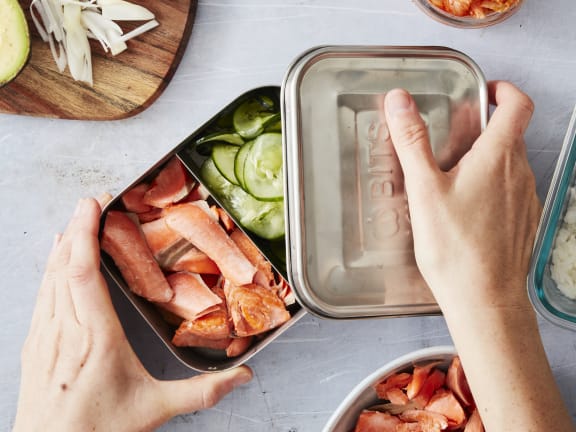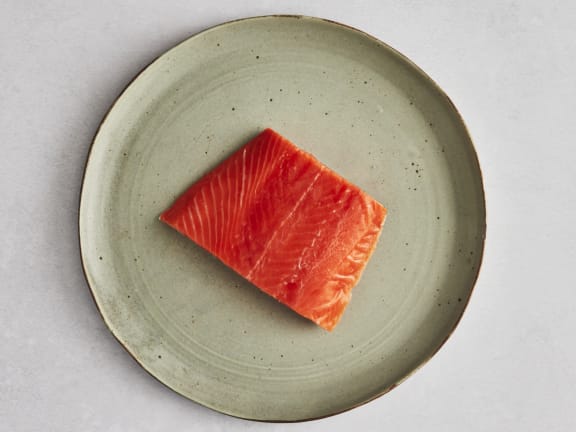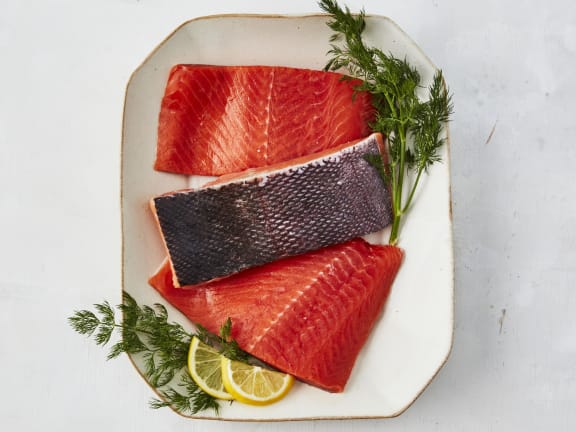While consumers are pretty familiar with how to store fresh poultry or meat, knowing how to store salmon — and how to keep salmon fresh — is less common knowledge. In actuality, the rules are easy to follow. We’ve put together a guide on how to store salmon to keep it fresh while it’s in your refrigerator.
How to Store Raw Salmon
To store thawed, raw salmon in the freezer, move the fillet from the pan/sheet tray and into a covered container or resealable bag to prevent drying out. You can also seal it tightly in plastic wrap, aluminum foil, or moisture-proof paper until ready to cook.
Once your salmon fillets have thawed, unless you're cooking them immediately, you'll want to store them properly for quality and freshness.
How Long Can Raw Salmon Stay in the Fridge?
Salmon can be stored in the refrigerator for up to two days per USDA guidance, once it’s fully thawed. When storing in the fridge, make sure your temperature is 40F/4.4C or colder to ensure it won’t go bad sooner than two days.
How Long Can Cooked Salmon Stay in the Fridge?

Cooking the salmon helps to extend its lifespan a little longer than its raw counterpart. We generally advise to use leftover salmon within three to four days of cooking. After that, you run the risk of eating spoiled seafood. To help you enjoy leftover salmon before it spoils, we’ve compiled a list of easy leftover salmon recipes you can make with cooked salmon.
How Long Can Salmon Stay in the Freezer?
For optimal freshness, you can store frozen salmon in the freezer until you know you’re ready to cook it. Our recommendation is to enjoy the salmon within 3 months ideally, or up to a year. Beyond that, the quality may diminish, but it is safe to eat indefinitely.
Make sure you handle your salmon with care if it’s still in vacuum-sealed packaging, as being too rough with it will break the seal and expose it to freezer burn.
Can You Refreeze Thawed Salmon?

A lot of folks wonder if it’s safe to refreeze proteins. The short answer is yes, you can refreeze raw salmon safely, but there are some key points to remember.
The main point to remember is that it is safe to refreeze salmon that has been “slow” thawed in the refrigerator, as outlined in our guide to thawing salmon. It is NOT safe to refreeze salmon that has been “quick-thawed” in a bowl of cold water.
According to the USDA, you can refreeze salmon that has been thawed in the fridge as long as it has maintained refrigerator temperatures — meaning it’s cold to the touch, thus preventing any bacteria from growing. You can also freeze portions of unused fish.
It’s important to note, though, that refreezing raw salmon will impact its quality due to loss of moisture. There will always be some loss of moisture when ice crystals form and then melt. This leaves the seafood a little less succulent each time and damages the texture of the protein itself. The less efficient the freezing process — in other words, the longer it takes for seafood to freeze — the more the product will suffer as a result.
That’s why the process of flash freezing is one of the most important steps in getting fresh, high-quality seafood to your doorstep. It’s what sets the freshest tasting fish apart from the “fresh” fish at grocery stores.
By the time you see the thawed fish in grocery store displays, they’ve likely been frozen and thawed at least two times. In contrast, flash-freezing fish shortly after it has been caught — and keeping it frozen when possible throughout processing — helps to maintain the quality of the salmon from catch to doorstep.
Can You Freeze Cooked Salmon?
 Yes, though there are certain preparations of salmon that freeze better than others. You can refreeze cooked salmon, but we find that it works best for meals such as these delectable salmon cakes, as the accompanying ingredients in the preparation help to keep the salmon moist when frozen and reheated. With cooked salmon that has been frozen, it’s best to consume it within a month or so for best possible quality.
Yes, though there are certain preparations of salmon that freeze better than others. You can refreeze cooked salmon, but we find that it works best for meals such as these delectable salmon cakes, as the accompanying ingredients in the preparation help to keep the salmon moist when frozen and reheated. With cooked salmon that has been frozen, it’s best to consume it within a month or so for best possible quality.
While you may lose some quality in the fish, freezing cooked salmon is a great method for people who like to meal prep salmon in advance. You lose out on some flavor, but it makes weekday meals easier.
If you’re planning on freezing cooked salmon, allow the fish to cool to room temperature (or even cool it in the refrigerator) before moving it to the freezer. If you don’t, the steam coming off the warm food will turn into ice crystals and create freezer burn (yikes!). Make sure you don’t freeze any foods left outside the refrigerator longer than 2 hours, or food left out 1 hour in temperatures above 90F.
How to Tell If Salmon Is Bad
According to the USDA, one way you can tell if salmon is bad is by smelling it. Uncooked spoiled seafood can smell sour, rancid, fishy, or like ammonia. These odors become stronger after cooking. If you pick up any of these scents in cooked salmon, whether faint or potent, don’t eat it.
Salmon that’s spoiled will also have a change in appearance different from when it was first defrosted, such as a change in color, or a visible change in its texture. And if you decide to taste your salmon to determine if it’s fresh, it will have an off or sour taste to it.
Get Access to the Best Wild-Caught Salmon

Be sure to stock your kitchen with sustainably-caught fish and shellfish by sourcing your seafood online from Wild Alaskan Company. You’ll get high-quality, wild-caught seafood delivered straight to your doorstep. Choose your fish subscription box today.






